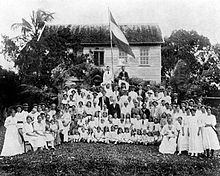History
Colonial period

Maroon village, Suriname River, 1955
In 1683, the Society of Suriname was founded by the city of Amsterdam, the Van Aerssen van Sommelsdijck family, and the Dutch West India Company. The society was chartered to manage and defend the colony. The planters of the colony relied heavily on African slaves to cultivate the coffee, cocoa, sugar cane and cotton plantations along the rivers. Planters' treatment of the slaves was notoriously bad, and many slaves escaped the plantations.
With the help of the native South Americans living in the adjoining rain forests, these runaway slaves established a new and unique culture that was highly successful in its own right. They were known collectively in English as the Maroons, in French as the Nèg'Marrons (literally meaning "maroon neg[roes]", that is "runaway negro slaves"), and in Dutch as Bosnegers (literally meaning "forest negroes"). The maroons gradually developed several independent tribes through a process of ethnogenesis, as they were made up of slaves from different African ethnicities. Among them are the Saramaka, the Paramaka, the Ndyuka or Aukan, the Kwinti, the Aluku or Boni, and the Matawai.
The Maroons often raided the plantations to recruit new members from the slaves and capture women, as well as acquire weapons, food and supplies. The planters and their families were sometimes killed in the raids; colonists built defenses, which were so important they were shown on 18th-century maps, but these were not sufficient. The colonists also mounted armed campaigns against the Maroons, but they generally escaped through the rainforest, which they knew much better than did the colonists. To end hostilities, in the 19th century the European colonial authorities signed several peace treaties with different tribes. They granted the Maroons sovereign status and trade rights in their inland territories.
Abolition of slavery

Javanese immigrants brought as contract workers
from the Dutch East
Indies. Picture taken between 1880–1900.
As a plantation colony, Suriname was still heavily dependent on manual labour, and to make up for the shortfall, the Dutch brought in contract labourers from the Dutch East Indies (modern Indonesia) and India (through an arrangement with the British). In addition, during the late 19th and early 20th centuries, small numbers of mostly men were brought in from China and the Middle East. Although Suriname's population remains relatively small, because of this history it is one of the most ethnically and culturally diverse countries in the world.
On 23 November 1941, under an agreement with the Netherlands government-in-exile, the United States occupied Suriname to protect bauxite mines. In 1954, Suriname became one of the constituent countries of the Kingdom of the Netherlands, along with the Netherlands Antilles and the Netherlands. In this construction, the Netherlands retained control of defense and foreign affairs. In 1973, the local government, led by the NPK (a largely Creole, meaning ethnically African or mixed African-European, party) started negotiations with the Dutch government leading towards full independence, which was granted on 25 November 1975. The severance package was very substantial, and a large part of Suriname's economy for the first decade following independence was fueled by foreign aid provided by the Dutch government.
Independence
The first President of the country was Johan Ferrier, the former governor, with Henck Arron (the then leader of the Nationale Partij Suriname (Suriname's National Party) as Prime Minister. In the years leading up to independence nearly one-third of the population of Suriname emigrated to the Netherlands, amidst concern that the new country would fare worse under independence than it had as an overseas colony of the Netherlands. Suriname's diaspora includes more than a quarter of a million people of Surinamese origin currently living in the Netherlands, including several recent members of the Dutch national football team.December killings
On 25 February 1980, a military coup overthrew the democratic government and declared a socialist republic. Between 2am and 5am on the morning of 7 December 1982, the military, under the leadership of Dési Bouterse, rounded up 15 prominent citizens who had criticized the military dictatorship in Suriname, and brought them to Fort Zeelandia. They were executed over the next three days, and the Netherlands quickly suspended all foreign aid to Suriname. Bouterse is being tried for the murders, but the Suriname parliament has passed a law that grants Bouterse amnesty for the alleged violations. The Dutch government has stated that stopping the trial would be "totally unacceptable". Bouterse has been convicted in absentia in the Netherlands on drug smuggling charges.Elections were held in 1987, and a new constitution was adopted that, among other things, allowed Bouterse to remain in charge of the army. Dissatisfied with the government, Bouterse summarily dismissed them in 1990, by telephone. This event became popularly known as the "Telephone Coup". His power began to wane after the 1991 elections; an ongoing brutal civil war between the Suriname army and Maroons loyal to rebel leader Ronnie Brunswijk, begun in 1986, further weakened Bouterse's position during the 1990s.
Seeing the deterioration of the situation, Aruba, the Netherlands Antilles and the Netherlands considered inviting the country to rejoin the Netherlands as an "associated state" in 1991.
